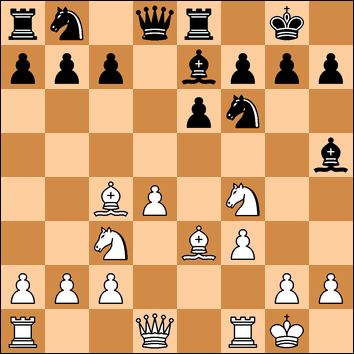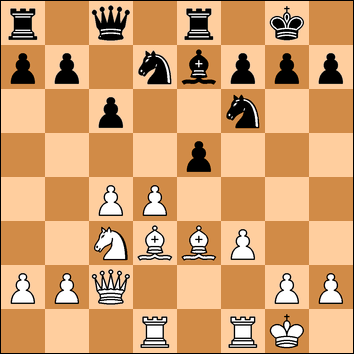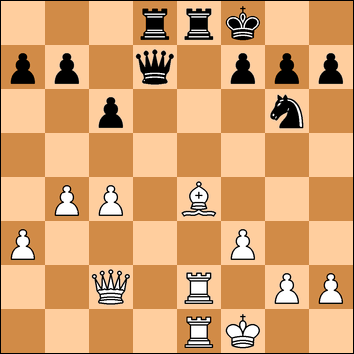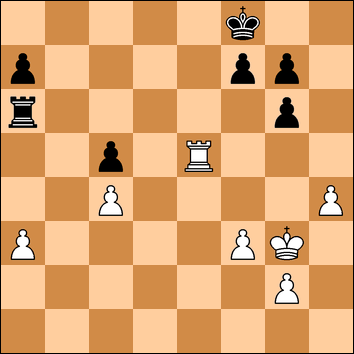Thursday 16 March 2017
White: K. Nevols (134) - Black: D. Simpson (105)
This was my first game against Dennis who had joined our club this season.
1. e4 d5
As someone who has played this opening numerous times, I am always curious to see how others handle it.
2. exd5 Qxd5
3. Nc3 Qd8
Black chooses the Qd8 version. Some people play 3. .. Qd6. I prefer 3. .. Qa5. There is one line for White against 3. .. Qa5 which I have identified that puts Black under some pressure, but so far no-one has played it against me and, as no-one has also not played 3. .. Qa5 against me as Black, then I have not had the chance to try it out. Maybe one day.
4. d4 Nf6
5. Bc4 Bg4
I now realised the difference between the queen move to d8 as opposed to my usual Qa5. If now 6. Nf3 then Black has the option of 6. ... Bxf3 7. gxf3 making a mess of White's kingside while the king is still in the centre. Or maybe stronger is 6. ... Nc6.
Disliking both of these options, I decided to castle the king as quickly as I could.
6. f3 Bh5
7. Nge2 e6
8. O-O Be7
The computer likes the idea of Ng4 Bg6; Nxg6 but I did not want to open up the h-file while his rook was still on h8.
9. Be3 O-O
10. Nf4
Now it is OK to hit the bishop.
10. ... Re8!?
Better perhaps is 10. .. Bg6 or 10... Nbd7. I did not quite understand this move.

White could now play 11. Nxh5 Nxh5 12. d5! striking at the centre while he has the lead in development and Black has a knight offside. Play might follow 12. .. exd5 13. Qxd5 Qxd5 14. Nxd5 Bd6 or 13. Bxd5 c6 14. Bb3 or 13. Nxd5 Bd6. White would have his pieces in the centre and Black would have to be careful, but might have enough resources to defend with a timely Bd6 and Nf6.
Instead I continue for calm positional development which is more my style.
11. Nce2 Nbd7
12. Nxh5 Nxh5
13. Qd2
To be honest I am just moving pieces around, trying to think of a plan.
13. ... Nb6
14. Bd3 Nf6
While he was thinking, I saw 14 .. Nd5 and wondered if it was any good. 15. c4 could be answered with 15. .. Bb4 or 15. . Nxe3. Maybe 15. c3 would have been more solid. Instead Black wisely brings the knight back in to the centre.
My plus point here is that the knight on b6 looks a bit awkwardly placed. From playing this Scandinavian system myself, I know that Black can get a strong point around d5, or attack the pawn on d4, so I move my pieces about to take care of those possibilities.
15. c4 c6
The computer now recommends 16. a3 to limit the scope of the bishop and prepare Nc3. It rates the position as 0.83 in favour of White.
16. Qc2 Nbd7
17. Rad1 Qc8?!
Moving the queen away from the d-file is wise but 17. .. Qc7 is better. 18. Bf4 is easily answered with 18. .. Bd6 and after 19. Bxd6 Qxd6 the position is completely equal.
18. Nc3
I want to move to e4 and try to get an attack going on the kingside. I also want to somehow create a weakness amongst his kingside pawns.
18. ... e5!?
A surprise - but an interesting idea. Sometimes in the Scandinavian it is the c-pawn which moves forward while the e-pawn keeps guard on squares closer to the king. Black's idea is to gain space by exchanging pawns in the centre. Now White ought to play 19. Bf5 to grab hold of that square and then perhaps 19... Qc7 20. Ne4.

19. Rfe1 exd4
20. Bxd4 Bc5
21. Bxc5
The computer argues that 21. Qf2 is an improvement. 21. .. Bxd4 22. Qxd4 Rxe1+ 23. Rxe1 and the queen is very well placed, but I have decided that I want a black piece to be on c5 so that I can gain a tempo when I attack it with b4.
21. ... Nxc5
22. Bf5 Qc7
23. b4 Ncd7
24. a3
A precaution against Qb6+.
24. ... Ne5
25. Ne4 Nxe4
26. Bxe4 Ng6
Black has defended very well, we are running out of pieces, and, by now, I was getting frustrated at the lack of weaknesses in the black position.
27. h4?! is well answered by 27. .. Re5 28. g4 h5! If 27. Bxg6 then we might as well shake hands straight away. And we must not forget Black's own possibility of counterplay with .. a5.
The computer recommends 27. g3 perhaps with Kg2 and a slow advance. That might not have been a bad plan. Instead I decide to double rooks for something to do.
27. Re2 Rad8
28. Rde1 Qd7
29. Kf1 Kf8

It felt like stalemate with neither of us thinking of anything to do.
Again 30. g3 is perhaps best. Instead more pieces come off.
30. Re3
The plan was to come to d3 but of course Black does not allow that.
30. ... Qd2
31. Qxd2 Rxd2
32. Bxg6 Rxe3
33. Rxe3 hxg6
Well, I've got the weakness - but a very tiny one.
34. Kg1 Rd7
34. .. Rd4 might have been more accurate.
At this point, Black now offered a draw. I decided I wanted to play on a little more but was ever mindful of the fact that I had blown an equal rook ending not so long ago.
The plan is to advance on the kingside and see if anything happens.
35. Kf2 b6
36. Kg3 Rd6
Again 36. .. Rd4 is better with 37. Rc3 a5 and Black could get an initiative.
37. h4 c5
38. bxc5 bxc5
39. Re5 Ra6
Still dead equal.

40. Re3 Ra4
41. Rc3 Ke7
42. Kf4 f6
43. Ke4 Ke6
44. g4 f5+
45. Kf4 Kf6
46. g5+ Ke6
47. Ke3 Ke5
48. f4+
And now I offered the draw which was agreed. The position is completely dead.
My opponent had played well but I was not happy with my play. I should have mixed it up somewhere and try to engage in open battle. Careful manoeuvring is not much good against someone who is good at defence.
No comments:
Post a Comment